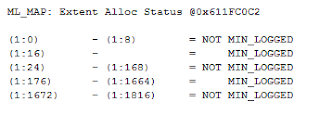In the last post , we have discussed about the Differential Change Map pages and how it is utilized in the differential backup process.In this post, let us try to understand the bulk change map page and how the bulk logged recovery model works.
Bulk Change Map(BCM): SQL Server uses Bulk Change Map (BCM) page to track extent modified by bulk logged operation since last backup log operation. BCM page is the 7th page in the data file.BCM has a bit for every extent it tracks. If the bit is 1, the corresponding extent is modified after the last log backup due to bulk logged operation, if the bit is 0, there is no change in the corresponding extent due to bulk logged operation after the last log backup.A BCM page can hold information of around 64000 extents. Precisely BCM pages repeat after every 511232 pages .One BCM page can track the changes of exactly 63904 extents.The second BCM page will be 511239th page.
You can see the BCM pages in all the databases, but they are only relevant when the database is in the bulk recovery model.In this recovery model, while taking log backup, SQL server scans the BCM page and include the extents that are marked as changed in the log backup along with transaction log.This helps SQL server to make bulk logged operation to be recoverable if the database is restored from database backup and a sequence of transaction log backups.In the bulk logged recovery model, bulk logged operation like BCP,Bulkinsert,Select Into are minimally logged in the transaction log and modified extents are tracked through the BCM pages.This helps SQL server to have optimized performance for bulk operations.
BCM pages are not relevant in simple recovery and full recovery model. In simple and full recovery model, the bulk logged operation are treated as fully logged operation. In short, in simple and bulk recovery model, BCM page will not keep track of the changes happened through bulk logged operations.
Let us try to understand with a sample.
CREATE DATABASE Mydb
GO
ALTER DATABASE Mydb SET RECOVERY BULK_LOGGED
BACKUP DATABASE Mydb TO DISK='D:mydb.bak'
GO
DBCC TRACEON(3604)
DBCC PAGE('MYDB',1,7,3)
From the output ,it is clear that none of the extents are changed due to bulk logged operations. Let us try to perform a bulk logged operation.
SELECT * INTO mydb..SalesOrderDetail FROM AdventureWorks2008.sales.SalesOrderDetail
DBCC PAGE('MYDB',1,6,3)
Now in the output, you can see two entries marked as MIN_LOGGED.The first one is due to the change in the IAM page and second one is the actual data inserted as part of Select Into operation.Now when we take a log backup, SQL server backups the transaction log changes along with extent marked as changed in the BCM file. After the log backup, the bits in the BCM pages are flipped to mark there is no extent changed due to the bulk logged operation. Let us take the log backup.
From the output, we can see that SQL server flipped the bit in BCM page and none of the extents are marked as changed due to the bulk logged operation. Note that BCM pages are not cleared by taking a full backup or differential backup.The base of the transaction log backups is the previous transaction log backup. SQL server should know what changes are happened between two transnational log backup.If a differential or full backup cleared the BCM page,next transaction log backup can not track/recover the changes between the previous log backup and full/differential backup. In short a full backup or differential backup will not break the transaction log backup chain.
If you liked this post, do like my page on FaceBook



